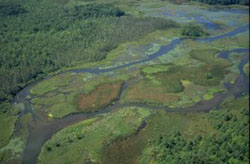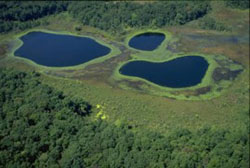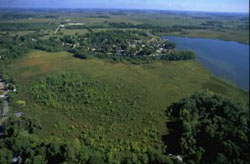Overview
When you think of wetlands, what do you think of? Do you see mud and bugs? Ducks and cattails? Lily pads and frogs? Do you think of areas with limitless potential, or areas that should be converted into "useful ground"? We all think of different things when we think about wetlands and our ideas about wetlands may be based on some very outdated ideas.
Nationally, since the late 1600s we have lost roughly 50% of the wetlands in the lower 48 states. Indiana has lost a large number of its wetlands. In the 1800s and 1900s we converted millions of acres of wetlands into farms, cities, and roads, and we converted wetlands to protect our health. Before we began converting wetlands, there were over 5.6 million acres of wetlands in the state, wetlands such as bogs, fens, wet prairies, dune and swales, cypress swamps, marshes, and swamps. In the early 1700s, wetlands covered 25% of the total area of Indiana. That number has been greatly reduced. By the late 1980s over 4.7 million acres of wetlands had been lost - wetlands now cover less than 4% of Indiana.
Times have changed.
Far from being "wastelands", we now know that wetlands have much to offer both humans and nature. We continue to expand our knowledge of the delicate interrelationship of natural systems. We now recognize that wetlands contribute in remarkable ways to our health, economy, quality of life and the well-being of the natural environment.
Wetlands and the functions they provide vary. Whether a specific wetland performs these functions depends on many variables including: wetland type, size, previous physical influences/natural or human-induced, location of the wetland in the landscape and the surrounding land use. Wetlands also change over time and may function differently from year to year or season to season. Wetlands are dynamic ecosystems.
What Wetlands Do

Tamarack Bog Nature Preserve, Pigeon River Fish and Wildlife Area, LaGrange County - Rich Fields, IDNR Division of Public Information and Education
Wetlands are home to wildlife. More than one-third (1/3) of America's threatened and endangered species live only in wetlands, which means they need them to survive. Over 200 species of birds rely on wetlands for feeding, nesting, foraging, and roosting. Wetlands provide areas for recreation, education, and aesthetics. More than 98 million people hunt, fish, birdwatch, or photograph wildlife. Americans spend $59.5 billion annually on these activities.

Seven Sisters, ACRES Inc. Steuben County - Rich Fields, IDNR Division of Public Information and Education
Wetland plants and soils naturally store and filter nutrients and sediments. Calm wetland waters, with their flat surface and flow characteristics, allow these materials to settle out of the water column, where plants in the wetland take up certain nutrients from the water. As a result, our lakes, rivers and streams are cleaner and our drinking water is safer. Man-made wetlands can even be used to clean wastewater, when properly designed. Wetlands also recharge our underground aquifers - over 70% of Indiana residents rely on ground water for part or all of their drinking water needs.

Wawasee Wetlands Nature Preserve, IDNR Fish and Wildlife, Rich Fields, IDNR Division of Public Information and Education
Wetlands protect our homes from floods. Like sponges, wetlands soak up and slowly release floodwaters. This lowers flood heights and slows the flow of water down rivers and streams. Wetlands also control erosion. Shorelines along rivers, lakes, and streams are protected by wetlands, which hold soil in place, absorb the energy of waves, and buffer strong currents.
For more information:
The U.S. Environmental Protection Agency has an excellent overview of the many ways wetlands help us and help the environment:
- Wetlands Fact Sheets: a comprehensive fact sheets containing summaries of wetlands topics ranging from delineation to mitigation banking.
- Functions and Values of Wetlands: a summary of the ecological productivity and beneficial functions of wetlands.
- America's Wetlands - Our Vital Link Between Land and Water: provides a broad overview of wetland types, values, status, and protection efforts with photos and charts to illustrate each topic.
